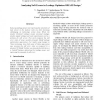VLSID
2003
IEEE
15 years 24 days ago
2003
IEEE
Reducing leakage power and improving the reliability of data stored in the memory cells are both becoming challenging as technology scales down. While the smaller threshold voltag...
VLSID
2005
IEEE
15 years 24 days ago
2005
IEEE
One of the main challenges for design in the presence of process variations is to cope with the uncertainties in delay and leakage power. In this paper, the influence of leakage r...
VLSID
2007
IEEE
15 years 24 days ago
2007
IEEE
Leakage power is becoming a dominant contributor to the total power consumption and dual-Vth assignment is an efficient technique to decrease leakage power, for which effective de...
VLSID
2008
IEEE
15 years 24 days ago
2008
IEEE
Continuous technology scaling has resulted in an increase in both, the power density as well as the variation in device dimensions (process variations) of the manufactured process...
DAC
2006
ACM
15 years 1 months ago
2006
ACM
Transistor leakage is poised to become the dominant source of power dissipation in digital systems, and reconfigurable devices are not immune to this problem. Modern FPGAs already...
DAC
2004
ACM
15 years 1 months ago
2004
ACM
We investigate trade-offs in microprocessor frequency and system power achievable for low temperature operation in scaled high leakage technologies by combining refrigeration with...
DAC
2002
ACM
15 years 1 months ago
2002
ACM
Reducing power dissipation is one of the most principle subjects in VLSI design today. Scaling causes subthreshold leakage currents to become a large component of total power diss...
DAC
2008
ACM
15 years 1 months ago
2008
ACM
Temperature hot-spots have been known to cause severe reliability problems and to significantly increase leakage power. The register file has been previously shown to exhibit the ...

